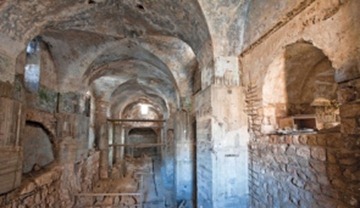Over the past 40 years, the Ottoman-built mid-19th-century Kishle compound in the Old City of Jerusalem has been closed to visitors.
 The impressive 450-meter arched structure, which includes a former prison, contains artifacts from nearly every period in Jerusalem's history, from Herod to the Crusaders to the Jordanians.
The impressive 450-meter arched structure, which includes a former prison, contains artifacts from nearly every period in Jerusalem's history, from Herod to the Crusaders to the Jordanians.
Soon it will also feature something a bit more modern, though no less indicative of the ancient city's global sway: a Swedish string quartet playing a "visual concert" written by an American composer who combined the melodies with recorded, spoken voices.
The concert, Steve Reich's "Different Trains," is one of many performances and exhibits that the Tower of David Museum plans to hold in the Ottoman compound, once it turns it into a hall that it seeks to open to the public by June, at a cost of hundreds of thousands of shekels.
The new hall will host summertime cultural events that are part of the Jerusalem Season of Culture, sponsored by the Schusterman Foundation, with temporary platforms to be built over the ongoing archaeological excavations. In the future, the Tower of David Museum, which had 300,000 visitors in 2010, plans to use the Kishke compound to house temporary exhibits and shows while allowing visitors to take a look at the archaeological finds beneath their feet.
Shosh Yaniv, the museum's director, said the extra space afforded by the Kishle compound could allow the museum to expand operations, maybe "even to 24 hours a day," she said.
Barracks for Turkish soldiers
"Kishle" is the word the Ottomans used to refer to the barracks for Turkish soldiers. The prison was built within the walls of David's Citadel, unlike another building in the compound - the main headquarters building south of David's Citadel, which was originally built as a summer home for an Egyptian ruler. The jail continued to be used to hold prisoners during the British mandate and under Jordanian rule.
Members of the pre-state underground militias were held there, and one can still see on one of the walls a map of the Greater Land of Israel that includes both banks of the Jordan River. The Kishle jail stopped being used as a prison after Israel recaptured the Old City during the Six-Day War, and the nearby headquarters building became an Israeli police station.
About 10 years ago, the nearby Tower of David Museum sought to take over the Kishle compound in a bid to expand its exhibition space. But it was not a straightforward process.
"We wanted to prepare the large space for our education department," said Yaniv. "But when we began to check the space, it turned out that there needed to be extensive archaeological excavations there that ultimately ate up all our funding."
Those excavations turned up what appear to be two massive walls of Herod the Great's palace, beneath which archaeologists found a drainage system seven meters underground that transported sewage from the palace to a valley to its west. The finds are thought to be from between 37 and 4 B.C.E., which is when Herod reigned.
Other finds include eight pools from the Middle Ages, which appear to have been used to die cloth or process animal skins, and parts of the walls surrounding Jerusalem during the time of the Hasmoneans, in the second century B.C.E.
Author: Noam Dvir | Source: Haaretz [January 03, 2011]